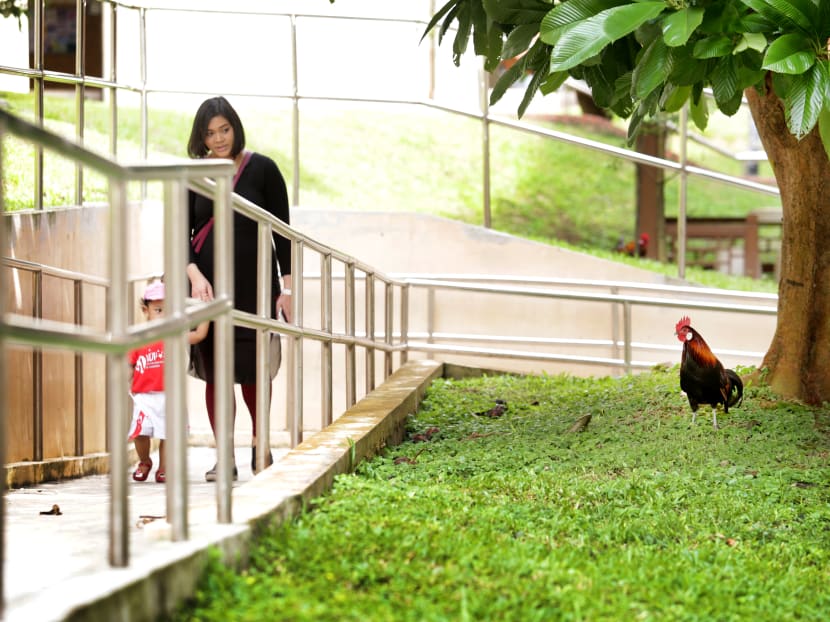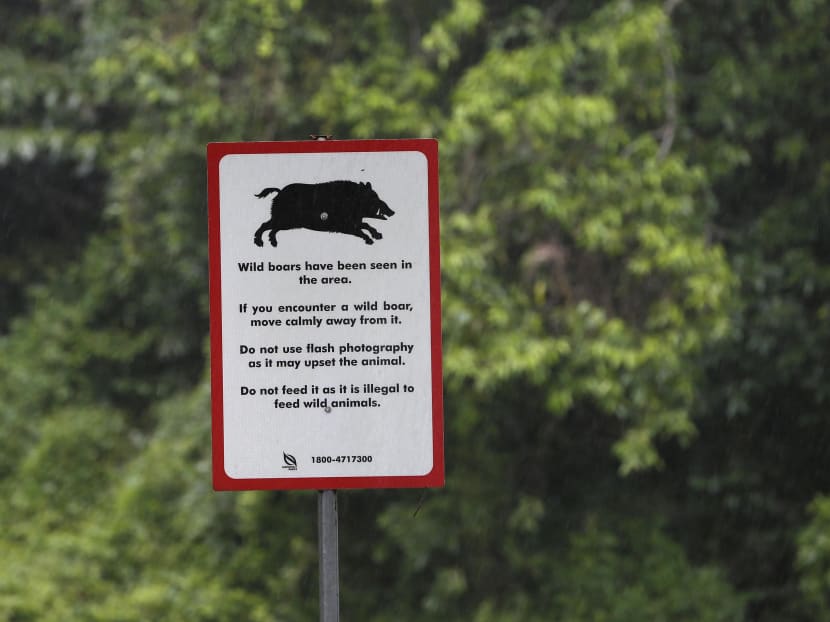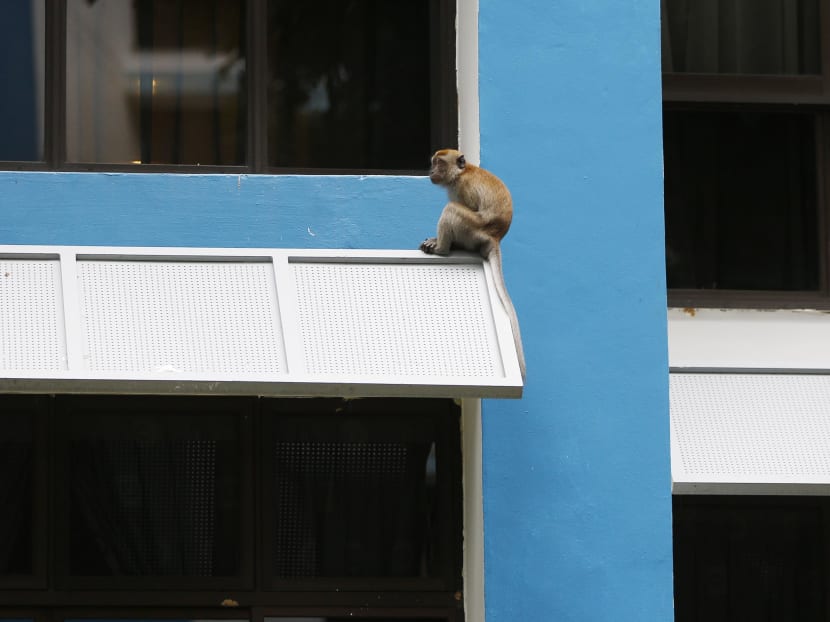The Big Read: As animal encounters hit the headlines, a divide opens up
SINGAPORE — A few months ago, Bukit Panjang resident Madam Sherry Yeo watched, stunned, as a monkey appeared at the windowsill of her 12th floor unit, and then made its way into her kitchen for a bite of her leftover red bean bun.







SINGAPORE — A few months ago, Bukit Panjang resident Madam Sherry Yeo watched, stunned, as a monkey appeared at the windowsill of her 12th floor unit, and then made its way into her kitchen for a bite of her leftover red bean bun.
“I’ve been living here for the last 10 years and have never seen monkeys in the area until they started appearing in November,” said the 44-year-old cleaning assistant living in Block 467 Segar Road.
The block of flats Mdm Yeo lives at faces Zhenghua Nature Park, which was recently expanded to provide a larger green space for residents and increase the green buffer for the Central Catchment Nature Reserve. The park’s 3.8ha extension was officially opened in 2015.
In recent months, Mdm Yeo has observed that at least one monkey will appear on most mornings and evenings, often climbing into residents’ homes, presumably in search of food. “They can mess up the house and eat our food. And after eating, they will defecate here and there,” she added in Mandarin.
Singapore may be the Garden City, but it is not always paradise: Be it monkeys, wild boars, or lately, chickens, the island has a long history of encounters between people and wildlife, and how they are handled have continued to provoke debate.
Two weeks ago, the Agri-Food and Veterinary Authority of Singapore (AVA) put down 24 free-roaming chickens around Thomson View and the Sin Ming area. It had received 20 complaints, mainly about noise, from nearby residents, and later explained that risk of exposure to bird flu prompted it to cull the chickens. It also said there was “clear scientific evidence” that the chickens are susceptible to the virus and could transmit the disease to humans.
The ensuring uproar saw some up in arms over what they felt was a “knee-jerk” response to a minor complaint; others said culling them would prevent possible contamination of the gene-pool of the red junglefowl, the wild and vulnerable cousins that live among them.
When animals and humans collide, culling is one method employed by the authorities — in the case of macaques and wild boars — much to the chagrin to wildlife activists, who question whether such decisions are backed by scientific data and studies, and whether this information can be made public.
A GREENER SINGAPORE, A GROWING PROBLEM?
Compared to the days of villagers being eaten by tigers, today’s tussles with crowing chickens and bun-eating monkeys seem mild, and could even be seen as an improvement.
According to Associate Professor Michael Gumert, a primatologist from Nanyang Technological University (NTU), such conflicts date back to the island's early years as a nation. A clash between humans and the long-tailed macaques was first recorded at the Singapore Botanic Gardens in the 1960s, and the animals were later culled in the 1970s.
“Heck, people used to be eaten by tigers in Singapore, so I would say conflict is much less now in terms of the average cost and potential damage per person. Another lower cost now is since no one farms, no one takes expensive crop losses,” he said.
While data on whether wildlife population has grown is inconclusive, two factors appear to contribute to the perception that conflicts are on the rise — urban development encroaching on the last of Singapore’s pockets of wilderness, while efforts at greening Singapore increasing the chances of encountering wildlife, setting the stage for clashes.
For example, families of smooth-coated otters are now often spotted in Singapore’s rejuvenated waterways — such as Kallang River @ Bishan-Ang Mo Kio Park — but some have also eaten koi from homes at Sentosa Cove, and fish from a farm in Pasir Ris Park.
As Singapore urbanises, less space is left for what could be the same number of animals, said founder of Animal Concerns Research and Education Society (Acres) Louis Ng, noting that much of the development has also taken place around the edge of the nature reserves.
“The animals have to go somewhere and they are coming into the urban areas… (for instance), we are seeing a lot of the pythons come out of our toilet bowls because they are using our drains as their new networks, their new roads. Obviously then the amount of conflict will increase,” said Mr Ng, who is also a Member of Parliament.
As encounters with the wildlife become more frequent, people start to develop a “fear about what these animals are and what will they do to me”, which then leads to more complaints, he added.
NUS Associate Professor Harvey Neo said the number of conflicts may appear to be on the rise, because of a vocal minority that have become less tolerant of particular forms of wildlife or nature. It does not help that the authorities seem to be reactive to such voices, he added.
Professor Agustin Fuentes from the Department of Anthropology in the University of Notre Dame in the United States, who has studied the monkey-human interactions here, noted that Singapore has also done well in keeping green spaces in the urban landscapes, and there could be more species around to engage in such conflicts, he added.
Dr Lena Chan, group director of the National Parks Board’s (NParks) National Biodiversity Centre, said NParks has made efforts to enhance and restore certain natural habitats, while at the same time, connecting the fragmented natural spaces.
As such there could be more sightings of wildlife — and interactions — when more people use green spaces like the parks. “Now whether that leads to conflict or not (boils) down to your attitude,” she said, adding that so-called conflicts usually arise when humans initiate action, such as feeding.
It is difficult to pinpoint whether the wildlife population here is increasing or not as the trend varies across different species. To date, there are about 1,500 long-tailed macaques, 500 wild boars and more than 50 smooth-coated otters.
Dr Chan said the act of feeding – similar to giving “fast-food” to these animals — will lead to animals thinking that food is available in an urban setting, and that they no longer need to hunt for food in the nature reserves.
Wildlife activist Vilma D’Rozario said that it is “dangerous” to suggest that more wildlife is thriving in these increased green spaces without proper studies.
“We do not want people to say, hey we have to cut back on what NParks is trying to do, to green our landscape,” she said, adding that this would then affect the green habitats for the wildlife.
Pointing out that Singapore has lost 95 per cent of its forests, while National Parks Board has created more parks than habitats, Assoc Prof Gumert said the wildlife population would not have grown.
CULLING THE RIGHT RESPONSE?
Regardless of wildlife population size, the AVA has generally been receiving an increasing number of wildlife-related feedback, said its spokesperson.
The authority did not respond to TODAY’s queries on the number of animals it has culled. But previous media reports showed that close to 630 monkeys were culled by the AVA in 2015. That same year, they received about 750 monkey-related complaints. In 2013, 570 monkeys were culled and had received about 1,870 related complaints.

In managing wildlife populations, AVA’s priority is to ensure that public health and safety are not compromised, she said.
Meanwhile, NParks’ approach to the human-wildlife conflicts is science-based, said Dr Chan. “If you don’t approach it from science (and have) a knee-jerk reaction, then you’ve got no leg to stand on later to say, ‘How do I defend this action?’” she noted.
Over the past two years, they have been studying and collecting data on the various wildlife species here, such as its population size and growth rate, demographics, living space, and how development is encroaching into their habitats.
But at least five to 10 years of study is needed for a more complete picture. In the meantime, Dr Chan said the authorities are also more mindful about taking any action before the data collection is complete.
“NParks is an agency responsible for biodiversity conservation, so we take it seriously... It has got to be backed by some science, long-term monitoring,” she added. In addition to complaints, other factors need to be considered in the management of human-wildlife interactions.
When asked if there is a threshold before the authorities decide to take any action, Dr Chan noted that there is no “magic figure”.
In the case of the macaques, while NParks can do a population viability analysis by plugging information on demographics, population, food availability, among others into a formula, the situation is complicated by human factors — such as when humans feed the monkeys and lure them out of the forest.
For the wild boars, Dr Chan said the authorities made the decision to cull them in 2014, for instance, as studies found them to be “very damaging” to the Central Catchment Nature Reserve. They were eating the regenerated saplings and their population size was increasing very rapidly, she added.
Asked if NParks’ goals may clash with the AVA’s, and how the two agencies work together to manage human-wildlife conflicts, Dr Chan said the board works actively with the community to create awareness and educate the public on the importance of responsible behaviour in managing human-wildlife interactions.
This community includes AVA, residents, schools, the grassroots and various animal welfare groups, she added.
But ACRES’ Louis Ng felt culling was being done here on a complaints’ basis, rather than in a scientific way. “Such culling hasn’t been effective. If it has worked, it would have worked decades ago,” he added, citing studies that have shown how the culling of feral cats in Southern Tasmania have subsequently led to increases in population and activity. The same situation was seen in the culling of ferrets in the United Kingdom.
Mr Ben Lee, founder of nature conservation group Nature Trekker, said that there were other options — such as relocating the animals — which the authorities failed to explore. “The authorities should be more transparent when they want to cull, when providing information and data for the reason of culling,” he said.
NParks’ Dr Chan said wild animals have their own mechanisms for controlling their own population. “They can sense that if their population is getting high, they can sense that there is food limitation and space, they will do their own ways of managing their own population,” she added.
But within Singapore’s urbanised setting, where there are no predators such as the tigers, population of certain wildlife will increase because of the absence of these predators. In these cases, human beings have to play the predator role. “But to the best, we would like to leave it to nature and let them control,” said Dr Chan.
Others such as wildlife consultant Subaraj Rajathurai also felt that culling is a necessity in Singapore, particularly with exotic animals introduced into the natural environment.
Prof Fuentes felt that “Singapore is ahead of the game on hand” by actively managing human-wildlife interactions, but the Republic country also relies heavily on culling, which in many cases is “often a short-sighted and suboptimal response”.
LEARNING TO SHARE
Assistant Professor Frank Rheindt from National University of Singapore’s (NUS) Department of Biological Sciences urged a “healthy perspective” on the issue.
“Nowadays, Singapore’s growth has levelled out, and human wildlife conflict would therefore be at much lower levels than before – even if certain members of the public may perceive this differently,” he said.
Added Assoc Prof Gumert: “Wildlife conflict in Singapore is only an inconvenience, not a real meaningful conflict in terms of damaging peoples’ lives, like in other areas of South-east Asia.”
NParks’ Dr Chan also stressed the distinction between human-wildlife interaction and conflicts. “Not everybody thinks it’s a conflict ... The silent majority do appreciate (the wildlife) but they don’t write thousands of letters,” she added.
To ensure positive interactions with the animals, Singaporeans need to be educated about the wildlife, backed by science and data. “Unless people know the facts — and they can’t love something, appreciate something, if they don’t know anything about it,” said Dr Chan.
NUS’ Dr Neo noted that people who complain about animals may not be persuaded by science. “Telling the one person who encounters a wild boar that the wild boar population is actually manageable will not make any difference to their perceptions if they are ill-disposed to the animal in the first place,” he added.
Assoc Prof Gumert, commenting on the varied response to the culling of different animals, attributes to anthropomorphism. “We love animals that are cute and cuddly and tend not to care about animals that are not. I think our disdain for culling is mostly driven by this, and not a general concern for life,” he added.
That said, the management of human-wildlife conflicts should move away from being too complaint-oriented, where “complaints seem to supersede the science and ecology of wildlife population management”. Rather than turn to the public for answers, wildlife experts and ecologists should set ground rules.
“Public sentiment towards which animals to save (is) pretty much governed by the same psychological mechanisms by which we pick stuffed animals at the toy store, while decisions to eradicate animals are easily driven by selfish motivations to clear out everything we conflict with,” he said.
By 2030, the goal is to have nine in 10 homes within 400m of a park, as set out in the 2015 Sustainable Singapore Blueprint. “We are aware, all the time, that there will be potential for interactions ... But on the other hand, there are other segments of the population who really like it and say we really want more parks,” said Dr Chan.
The authorities want to provide pockets of nature near where people live for a better living environment, she noted. “But at the same time you also have wildlife and wildlife actually use these spaces, and you can’t tell them, ‘this is reserved, stop here,’...It’s better for people to appreciate wildlife and live harmoniously,” said Dr Chan.









